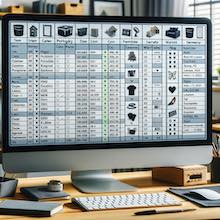Maintaining a home inventory is essential for various reasons, from personal organization and budgeting to insurance purposes. Spreadsheets offer a straightforward and effective way to create and manage a home inventory. This guide is tailored for beginners or those seeking to enhance their spreadsheet skills, focusing on how to build and manage a home inventory using Excel.
Step 1: Set Up Your Spreadsheet
- Create a New Excel Workbook: Open Excel and start a new blank workbook.
- Name Your Columns: Label columns with headings such as Item, Category, Purchase Date, Cost, Location, Warranty, and Notes. This will help organize your inventory effectively.
Step 2: Categorize Your Items
- Organize by Categories: Group items into categories like Electronics, Furniture, Appliances, Clothing, etc. This makes it easier to locate and manage items in your inventory.
- Use Separate Sheets for Each Room: Consider using separate sheets for different rooms or areas of your home for more detailed organization.
Step 3: Fill in Item Details
- Enter Item Information: For each item in your home, enter the relevant details under each column. Be as detailed as possible.
- Include Receipts and Warranties: If possible, note down information about warranties or attach digital copies of receipts and warranties.
Step 4: Add Photos
- Insert Photos: Add photos of items, especially valuable ones. You can insert images in Excel cells or include links to digital photos stored elsewhere.
Step 5: Update Regularly
- Keep Your Inventory Updated: Regularly update your inventory as you acquire or get rid of items. This ensures your inventory is always current.
Step 6: Format Your Spreadsheet
- Adjust Column Widths and Row Heights: Make sure all text and images fit neatly in the cells.
- Apply Conditional Formatting: Use conditional formatting to highlight items that need to be replaced or have warranties expiring soon.
Step 7: Utilize Data Filtering
- Use Filters: Excel's filter function allows you to view specific subsets of your inventory, like items in a particular category or price range.
Step 8: Secure Your Inventory
- Protect Your Data: Since a home inventory can contain sensitive information, consider password-protecting your Excel file.
- Backup Your Spreadsheet: Keep a backup of your inventory in a secure location, such as cloud storage.
Step 9: Create Summaries
- Use Excel Functions: Utilize functions like SUM to calculate the total value of items in a category or your entire inventory.

Conclusion
A well-maintained home inventory spreadsheet can be invaluable for personal organization, budgeting, and insurance claims. Excel’s user-friendly interface and customizable features make it an ideal tool for this purpose.
For more resources on using Excel for home and personal management, explore Spreadsheet Downloads. Our platform offers a range of templates and guides to help you harness the power of spreadsheets for everyday organization and efficiency.